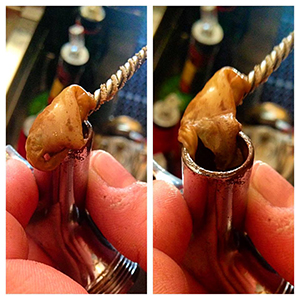
The chef was eager to be one of the first to arrive at the farmer’s market and have his pick of the freshest — and priciest — offerings he could get his hands on.
Once in the kitchen, he flipped on the lights, unsheathed his favorite knife and used his fingernail to scrape off the bits of dried food that had accumulated all over it. He grabbed a pot that had a layer of old soup caked on the bottom, added water and threw it on the stove top. He took some old dishwater and rinsed it over the beautiful veggies. When his first creation was ready, he took a plate and delicately placed the food squarely on top of last night’s residue.
It’s pretty clear what’s wrong with that picture, and it would be rare to find a top-caliber chef disrespecting his ingredients — and his guests — in that way.
But believe it or not, this is exactly what’s happening with the draft beer systems at countless bars and restaurants around the country each night. Fresh, beautiful beers are being poured through draft lines and equipment that are disgustingly filthy. And while most health inspectors comb through every inch of the kitchen meticulously, very few ever look at the state of the draft system. That responsibility falls on the owners and the management to maintain, and because the lines are often hidden behind walls and out of sight, they become out of mind.

Ensuring a draft system is in optimal condition is easier than you might think, and quite simply means more profit in your pocket. Additionally, if left too long, equipment can become so dirty that the only solution an operator can resort to is a costly rebuild of the system.
“The draft system is one of the most overlooked revenue generators in a restaurant,” said Tim Stendahl, assistant marketing manager for Union Beer Distributors, based in New York City. “Having clean lines carries the obvious benefit of serving fresher beer, which will lead to repeat purchases and higher check averages. On the flip side, dirty draft lines don’t just taste bad, they also cause excessive foaming, which is immediate lost revenue.”
Any beverage director or bar manager will tell you that on a per unit basis, draft beer holds a higher profit margin than bottled beer. It’s simple economics, and in the dollar-and-cents world of restaurant operations, watching every cent can mean the difference between success and failure.
Brewers spend countless hours trying to maintain the highest, freshest quality of beer they can provide to their customers.
“We go through all this effort to ship out the best beer possible,” said Jonathan Moxey, brewer at Perennial Artisan Ales in St. Louis. “And we work with distributors who go to great lengths to store the beer correctly, ensure it’s safe in transit, and then it all comes down to this last line of defense: the bar. All that work is for naught if the beer is being served through a dirty system.”
Beer contains proteins, carbohydrates and hundreds of organic compounds, and when that beer sits in the draft lines that transfer it from keg to faucet, deposits build up on the surfaces they contact. In only a matter of days, yeast and bacteria attach to the draft lines and begin to feed on the beer, as well as leave mineral deposits in the lines and fixtures.
Thankfully, this process will rarely make a guest sick (the alcohol in beer makes it nearly impossible for it to carry pathogens), but what it will do is greatly affect the quality of the product being served, quickly turning off guests from ordering that second draft beer. This means lost sales, or that guest are moving into less profitable choices from your bar, like cocktails and bottled beer.
“This is not rocket science,” said Jon Lundbom, division manager for B. United International, an importer of some of the world’s most prestigious breweries. “You clean your plates and glasses, so why not your beer lines? Lost sales and loss of reputation are a big deal. Our beer can't be everywhere, and there are only so many bars that do it right. So we’re selective and have to educate our accounts to make sure their systems are well maintained. We want the beer in the same condition that you’d have it in the brewery.”
Guidelines for maintaining tap lines
(Continued from page 1)
Different states have different rules. Some require the bars and restaurants to hire third-party services to maintain cleanliness, while other states require the breweries or distributors to clean the draft lines of their accounts. Furthermore, many serious craft beer bars even take it on themselves and purchase the necessary equipment to do it in-house. But regardless of who is doing the actual cleaning, operators need to ensure for themselves that the work is done to acceptable levels.
“Why would you put your reputation in the hands of someone else?” Moxey asks. “Yes, there are third-party cleaners and good distributors that do a great job, but don’t leave that to chance. And not knowing the last time that your lines were cleaned? That’s not good enough.”

What is your restaurant or bar's draft line maintenance plan? Join the conversation in the comments below.
The Brewers Association, which represents the interests of craft breweries in the United States, has spent years developing guidelines for maintaining your draft systems, and has compiled that information online in a free document called the Draft Beer Quality Manual.
By taking a few minutes to familiarize yourself with these suggestions, as well as to better understand what problems to look out for, an owner can drastically improve the quality of product she’s serving to her guests.
“Draft lines should be cleaned every two weeks,” Stendahl said. “And faucets and couplers should be cleaned once a month. This requires a 2-percent caustic solution to dissolve any beer stone — a fancy word for gunk build-up — in the lines, and a cold water rinse. An acid flush is recommended at least once a quarter to clear away anything that regular cleaning has not been able to clean.”
And, as my grandma always said, a stitch in time saves nine.
“When you look at the actual cost of cleaning lines, maybe $50 to $100 depending on the amount of taps one has, it’s a minimal investment,” Lundbom said. “The profits are already huge, and to skimp on paying for the cleaning is short-sighted. You really can’t see it or taste it until it’s a big problem. And if it gets to the point where your beer tastes like fungus, cheese or copper, it’s too late. You’ll need to put new lines in altogether, and depending on your set-up, that can cost thousands of dollars.”
It’s possible to serve bad beer through a good system, but it’s impossible to serve good beer through a bad one. If handled properly, your high-quality beer may stay fresh for months. But if handled improperly, it will not only become a poor reflection on your business, but on the brewery from which it came.
Do the right thing for all: Clean your lines and respect the equipment you invested in. It will make all the difference in the long run.
This story has been revised to reflect the following correction:
Correction: June 4, 2015 An earlier version of this story misstated the photo credit of the beer tap line. The photo is from Draft Choice.





